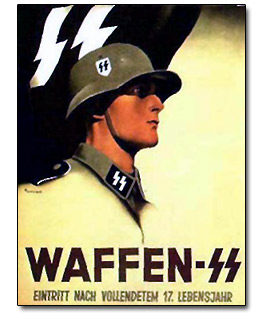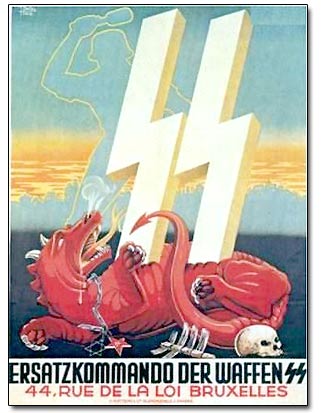Waffen SS (Schutzstaffel) - Armed SS
Brief History, page 1

The origins of the Waffen-SS ("Armed SS"), the combat arm of the Schutzstaffel ("SS"), can be traced back to the creation of a group of 200 men who were to act as Adolf Hitler's body guard in the early 1920s. This body guard was created by Hitler in reaction to his unease at the size and strength of the SA (Sturmabteilung, or "Storm Detachment").
The SA had grown so large that Hitler felt he needed an armed escort that was totally dedicated to him. Thus the Schutzstaffel (SS) or "protection squad" was created. After Hitler's imprisonment (and subsequent release) in the wake of the failed Munich Putsch in 1923, he saw an even greater need for a body guard, and the place of the SS was solidified in the Nazi hierarchy.
In addition to its police powers, the SS comprised a group of armed men that were used for security and ceremonial purposes. This organization was called the SS-Verfügungstruppe.
Hitler's protection squad, known as the Stabwache, was included in the SS-Verfügungstruppe. This protection squad had been created in March 1933 and would be the foundation for the 1st SS Panzer Division "Leibstandarte SS Adolf Hitler".
In 1935, Hitler mandated that the SS-Verfügungstruppen would be fully formed as a military unit. SS-Verfügungstruppen along with the Totenkopf formations would be the cornerstone of future Waffen-SS divisions.
Special schools at Bad Tölz and Braunschweig were created to train future SS officers. Reichsführer-SS Heinrich Himmler, head of SS, selected former Lieut. General Paul Hausser to oversee the training and schooling of the SS.
Hausser created two new SS regiments, "Deutschland" and "Germania." These regiments were formed from various battalions of the Verfügungstruppen and would be the foundation for the 2nd SS Panzer Division "Das Reich" and 5th SS Panzer Division "SS Division Wiking".

After the annexation of Austria, another regiment composed of Austrian Nazis named "Der Führer" was created. Thus, at the outbreak of hostilities, there were four SS armed regiments (although "Der Führer" was not ready for combat).
After the conclusion of the campaign against Poland, the three regiments of the Verfügungstruppen were joined to form the Verfügungsdivision. Leibstandarte was transformed into a motorized regiment. Also, two other divisions were created, the SS "Totenkopfdivision" and "Polizeidivision".
In March 1940, after an agreement between the Army and the SS, the title of Waffen-SS was officially given. The Waffen-SS took part in almost every major battle and were shifted from front to front, depending on the severity of the situation.
Several divisions are seen by historians as being elite, notably those with higher proportions of ethnic Germans in them. These divisions were characterized by extremely high unit morale and combat ability, as well as commitment to the ideals of the Crusade against Bolshevism. These divisions included the LSSAH, Das Reich, Totenkopf, the multinational Wiking, the Hohenstaufen and Frundsberg, and the Hitlerjugend.